Late Quaternary Evolution of a Submerged Karst Basin Influenced by Active Tectonics (Koločep Bay, Croatia)
Abstract
:1. Introduction
2. Study Area
2.1. Geographical Setting
2.2. Geological Setting
2.3. Structural Geology and Seismicity
2.4. Karst Hydrogeology
3. Materials and Methods
3.1. High-Resolution Seismic Survey
3.2. Sediment Coring
3.3. Sediment Core Analysis
3.4. Legacy Seismic Reflection Profiles of Koločep Bay
3.5. Legacy Bathymetric Maps
3.6. Statistical Analyses of Geochemical Data
4. Results
4.1. Mapping Quaternary Submarine Deposits of the Submerged Koločep Karst Basin
4.2. Sediment Core Lithology and Multi-Proxy Analysis
4.3. The Pleistocene “Paleo-River”
4.4. Evidence of Active Quaternary Submarine Tectonics
5. Discussion
5.1. Paleoenvironmental Reconstruction Based on Core Data
5.2. Paleoenvironmental Reconstruction Considering Sea-Level Fluctuation and the Interpretation of Seismostratigraphic Sequences
6. Conclusions
Author Contributions
Funding
Institutional Review Board Statement
Data Availability Statement
Acknowledgments
Conflicts of Interest
References
- Antonioli, F.; Anzidei, M.; Lambeck, K.; Auriemma, R.; Gaddi, D.; Furlani, S.; Orrù, P.; Solinas, E.; Gaspari, A.; Karinja, S.; et al. Sea-Level Change during the Holocene in Sardinia and in the Northeastern Adriatic (Central Mediterranean Sea) from Archaeological and Geomorphological Data. Quat. Sci. Rev. 2007, 26, 2463–2486. [Google Scholar] [CrossRef]
- Surić, M. Rekonstruiranje Promjena Morske Razine Na Istočnoj Obali Jadrana (Hrvatska)–Pregled, Reconstructing Sea-Level Changes on the Eastern Adriatic Sea (Croatia)–an Overview. Earth 2009, 14, 181–200. [Google Scholar]
- Lambeck, K.; Sambridge, M.; Rouby, H.; Purcell, A.; Sun, Y. Sea Level and Global Ice Volumes from the Last Glacial Maximum to the Holocene. Proc. Natl. Acad. Sci. USA 2014, 111, 15296–15303. [Google Scholar] [CrossRef] [Green Version]
- Benjamin, J.; Rovere, A.; Fontana, A.; Furlani, S.; Vacchi, M.; Inglis, R.H.; Galili, E.; Antonioli, F.; Sivan, D.; Miko, S.; et al. Late Quaternary Sea-Level Changes and Early Human Societies in the Central and Eastern Mediterranean Basin: An Interdisciplinary Review. Quat. Int. 2017, 449, 29–57. [Google Scholar] [CrossRef] [Green Version]
- Peltier, W.R.; Fairbanks, R.G. Global glacialice volume and Last Glacial Maximum duration from an extended Barbados sea level record. Quat. Sci. Rev. 2006, 25, 3322–3337. [Google Scholar] [CrossRef]
- Rovere, A.; Raymo, M.E.; Vacchi, M.; Lorschied, T.; Stocchi, P.; Gómez-Pujol, L.; Harris, D.L.; Casella, E.; O’Leary, M.J.; Hearty, P.J. The analysis of Last Interglacial (MIS 5e) relative sea-level indicators: Reconstructing sea-level in a warmer world. Earth Sci. Rev. 2016, 159, 404–427. [Google Scholar] [CrossRef] [Green Version]
- Lambeck, K.; Chappell, J. Sea Level Change through the Last Glacial Cycle. Science 2001, 292, 679–686. [Google Scholar] [CrossRef]
- Fairbanks, R.G. A 17,000-Year Glacio-Eustatic Sea Level Record: Influence of Glacial Melting Rates on the Younger Dryas Event and Deep-Ocean Circulation. Nature 1989, 342, 637–642. [Google Scholar] [CrossRef]
- Antonioli, F. Sea Level Change in Italy during Last 300 Ka. A Review. Biogeogr. J. Integr. Biogeogr. 2003, 24, 23–32. [Google Scholar] [CrossRef] [Green Version]
- Lambeck, K.; Antonioli, F.; Purcell, A.; Silenzi, S. Sea-Level Change along the Italian Coast for the Past 10,000 Yr. Quat. Sci. Rev. 2004, 23, 1567–1598. [Google Scholar] [CrossRef]
- Lambeck, K.; Purcell, A. Sea-Level Change in the Mediterranean Sea since the LGM: Model Predictions for Tectonically Stable Areas. Quat. Sci. Rev. 2005, 24, 1969–1988. [Google Scholar] [CrossRef]
- Anderson, H.; Jackson, J. Active Tectonics of the Adriatic Region. Geophys. J. R. Astron. Soc. 1987, 91, 937–983. [Google Scholar] [CrossRef]
- D’Agostino, N.; Avallone, A.; Cheloni, D.; D’Anastasio, E.; Mantenuto, S.; Selvaggi, G. Active Tectonics of the Adriatic Region from GPS and Earthquake Slip Vectors. J. Geophys. Res. Solid Earth 2008, 113, 1–19. [Google Scholar] [CrossRef]
- Govorčin, M.; Herak, M.; Matoš, B.; Pribičević, B.; Vlahović, I. Constraints on Complex Faulting during the 1996 Ston-Slano (Croatia) Earthquake Inferred from the DInSAR, Seismological, and Geological Observations. Remote Sens. 2020, 12, 1157. [Google Scholar] [CrossRef] [Green Version]
- Balascio, N.L.; Zhang, Z.; Bradley, R.S.; Perren, B.; Dahl, S.O.; Bakke, J. A Multi-Proxy Approach to Assessing Isolation Basin Stratigraphy from the Lofoten Islands, Norway. Quat. Res. 2011, 75, 288–300. [Google Scholar] [CrossRef] [Green Version]
- Long, A.J.; Woodroffe, S.A.; Roberts, D.H.; Dawson, S. Isolation Basins, Sea-Level Changes and the Holocene History of the Greenland Ice Sheet. Quat. Sci. Rev. 2011, 30, 3748–3768. [Google Scholar] [CrossRef] [Green Version]
- Benac, Č.; Juračić, M.; Blašković, I. Tidal Notches in Vinodol Channel and Bakar Bay, NE Adriatic Sea: Indicators of Recent Tectonics. Mar. Geol. 2008, 248, 151–160. [Google Scholar] [CrossRef]
- Vlahović, I.; Tišljar, J.; Velić, I.; Matičec, D. Evolution of the Adriatic Carbonate Platform: Palaeogeography, Main Events and Depositional Dynamics. Palaeogeogr. Palaeoclimatol. Palaeoecol. 2005, 220, 333–360. [Google Scholar] [CrossRef]
- Prtoljan, B.; Jamičić, D.; Cvetko Tešović, B.; Kratković, I.; Markulin, Ž. The Influence of Late Cretaceous Synsedimentary Deformation on the Cenozoic Structuration of the Middle Adriatic, Croatia. Geodin. Acta 2007, 20, 287–300. [Google Scholar] [CrossRef]
- Monroe, W.H. Glossary of Karst Terminology, 1st ed.; Geological Survey Water Supply Paper: Washington, DC, USA, 1970; p. 29. [Google Scholar] [CrossRef]
- Surić, M. Submarine karst of Croatia—Evidence of former lower sea levels. Acta Carsologica 2002, 31, 89–98. [Google Scholar] [CrossRef] [Green Version]
- Brunović, D.; Miko, S.; Hasan, O.; Papatheodorou, G.; Ilijanić, N.; Miserocchi, S.; Correggiari, A.; Geraga, M. Late Pleistocene and Holocene Paleoenvironmental Reconstruction of a Drowned Karst Isolation Basin (Lošinj Channel, NE Adriatic Sea). Palaeogeogr. Palaeoclimatol. Palaeoecol. 2020, 544, 109587. [Google Scholar] [CrossRef]
- Razum, I.; Miko, S.; Ilijanić, N.; Petrelli, M.; Röhl, U.; Hasan, O.; Giaccio, B. Holocene Tephra Record of Lake Veliko Jezero, Croatia: Implications for the Central Mediterranean Tephrostratigraphy and Sea Level Rise. Boreas 2020, 49, 653–673. [Google Scholar] [CrossRef]
- Dean, S.; Pappalardo, M.; Felja, I.; Juračić, M.; Boschaian, G. Karst landforms and prehistoric settlement patterns: A case study from Korčula Island (Croatia). Geogr. Fis. Dinam. Quat. 2020, 43, 31–43. [Google Scholar] [CrossRef]
- Kuk, V.; Prelogović, E.; Dragičević, I. Seismotectonically Active Zones in the Dinarides. Geol. Croat. 2000, 53, 295–303. [Google Scholar]
- Herak, M.; Herak, D.; Markušić, S. Revision of the Earthquake Catalogue and Seismicity of Croatia, 1908–1992. Terra Nov. 1996, 8, 86–94. [Google Scholar] [CrossRef]
- Navetić, L.J.; Petrović, V. Basic Geological Map of Trebinje M 1:100,000 K 34–37; Institute for Geological Survey: Sarajevo, Bosnia and Herzegovina; Federal Geological Survey: Beograd, Yugoslavia, 1964–1965.
- Raić, V.; Papeš, J.; Ahac, A.; Korolija, B.; Grimani, I.; Marinčić, S. Basic Geological Map of Ston M 1:100,000 K 33–48; Institute for Geological Survey: Sarajevo, Bosnia and Herzegovina; Federal Geological Survey: Zagreb, Yugoslavia, 1967–1968.
- Çaǧatay, M.N.; Eriş, K.; Ryan, W.B.F.; Sancar, Ü.; Polonia, A.; Akçer, S.; Biltekin, D.; Gasperini, L.; Görür, N.; Lericolais, G.; et al. Late Pleistocene-Holocene Evolution of the Northern Shelf of the Sea of Marmara. Mar. Geol. 2009, 265, 87–100. [Google Scholar] [CrossRef]
- Gràcia, E.; Bartolome, R.; Lo Iacono, C.; Moreno, X.; Stich, D.; Martínez-Diaz, J.J.; Bozzano, G.; Martínez-Loriente, S.; Perea, H.; Diez, S.; et al. Acoustic and Seismic Imaging of the Adra Fault (NE Alboran Sea): In Search of the Source of the 1910 Adra Earthquake. Nat. Hazards Earth Syst. Sci. 2012, 12, 3255–3267. [Google Scholar] [CrossRef] [Green Version]
- Beckers, A.; Hubert-Ferrari, A.; Beck, C.; Bodeux, S.; Tripsanas, E.; Sakellariou, D.; De Batist, M. Active Faulting at the Western Tip of the Gulf of Corinth, Greece, from High-Resolution Seismic Data. Mar. Geol. 2015, 360, 55–69. [Google Scholar] [CrossRef] [Green Version]
- Gasperini, L.; Marzocchi, A.; Mazza, S.; Miele, R.; Meli, M.; Najjar, H.; Michetti, A.M.; Polonia, A. Morphotectonics and Late Quaternary Seismic Stratigraphy of Lake Garda (Northern Italy). Geomorphology 2020, 371, 107–427. [Google Scholar] [CrossRef]
- Micallef, A.; Le Bas, T.P.; Huvenne, V.A.I.; Blondel, P.; Hühnerbach, V.; Deidun, A. A Multi-Method Approach for Benthic Habitat Mapping of Shallow Coastal Areas with High-Resolution Multibeam Data. Cont. Shelf Res. 2012, 39–40, 14–26. [Google Scholar] [CrossRef] [Green Version]
- Hasan, O.; Miko, S.; Brunović, D.; Papatheodorou, G.; Christodolou, D.; Ilijanić, N.; Geraga, M. Geomorphology of Canyon Outlets in Zrmanja River Estuary and Its Effect on the Holocene Flooding of Semi-Enclosed Basins (The Novigrad and Karin Seas, Eastern Adriatic). Water 2020, 12, 2807. [Google Scholar] [CrossRef]
- Korbar, T.; Markušić, S.; Hasan, O.; Fuček, L.; Brunović, D.; Belić, N.; Palenik, D.; Kastelic, V. Active Tectonic in the Kvarner Region (External Dinarides, Croatia)—An Alternative Approach Based on Focused Geological Mapping, 3D Seismological, and Shallow Seismic Imaging Data. Front. Earth Sci. 2020, 8, 582797. [Google Scholar] [CrossRef]
- Knies, J.; Nowaczyk, N.; Müller, C.; Vogt, C.; Stein, R. A multyproxy approach to reconstruct the environmental changes along the Eurasian continental margin over last 150,000 years. Mar. Geol. 2000, 163, 317–344. [Google Scholar] [CrossRef] [Green Version]
- Del Bianco, F.; Gasperini, L.; Giglio, F.; Bortoluzzi, G.; Kljaic, Z.; Ravaioly, M. Seafloor morphology of the Montenegro/N. Albania Continental Margin (Adriatic Sea-Central Mediterranean). Geomorphology 2014, 226, 202–216. [Google Scholar] [CrossRef]
- Bunzel, D.; Schmiedl, G.; Lindhorst, S.; Mackensen, A.; Reoild, J.; Romanhu, S.; Betzler, C. A multi-proxy analysis of Late Quaternary ocean and climate variability of the Maldives, Inner Sea. Clim. Past 2017, 13, 1791–1813. [Google Scholar] [CrossRef] [Green Version]
- Pikelj, K.; Juračić, M. Eastern Adriatic Coast (EAC): Geomorphology and Coastal Vulnerability of a Karstic Coast. J. Coast. Res. 2013, 29, 944–957. [Google Scholar] [CrossRef]
- Korbar, T. Orogenic evolution of the External Dinarides in the NE Adriatic region: A model constrained by tectonostratigraphy of Upper Cretaceous to Paleogene carbonates. Earth Sci. Rev. 2009, 96, 296–312. [Google Scholar] [CrossRef]
- Tišljar, J.; Vlahović, I.; Velić, I.; Sokač, B. Carbonate Platform Megafacies of the Jurassic and Cretaceous Deposits of the Karst Dinarides. Geol. Croat. 2002, 55, 139–170. [Google Scholar] [CrossRef]
- Surić, M. Submerged karst–Dead or alive? Example from the Eastern Adriatic coast (Croatia). Geoadria 2005, 10, 5–19. [Google Scholar] [CrossRef] [Green Version]
- Von Richthofen, F. Fuhrer für Forschungreisende; Verlag Von Gebrudek Janecke: Hannover, Germany, 1901; p. 734. [Google Scholar]
- Kelletat, D.H. Dalmatian Coasts. In Encyclopedia of Coastal Science (Encyclopedia of Earth Sciences Series); Schwartz, M., Ed.; Springer: Dordrecht, The Netherlands, 2005; pp. 355–356. [Google Scholar]
- Kastelic, V.; Vannoli, P.; Burrato, P.; Fracassi, U.; Tiberti, M.M.; Valensise, G. Seismogenic Sources in the Adriatic Domain. Mar. Pet. Geol. 2013, 42, 191–213. [Google Scholar] [CrossRef] [Green Version]
- Faivre, S.; Bakran-Petricioli, T.; Herak, M.; Barešić, J.; Borković, D. Late Holocene Interplay between Coseismic Uplift Events and Interseismic Subsidence at Koločep Island and Grebeni Islets in the Dubrovnik Archipelago (Southern Adriatic, Croatia). Quat. Sci. Rev. 2021, 274, 107284. [Google Scholar] [CrossRef]
- Faivre, S.; Bakran, P.T.; Herak, M.; Barešić, J.; Horvatić, D.; Borković, D. Late Holocene relative sea-level change and palaeoearthquakes at the Elafiti islands (Southern Adriatic, Croatia). In Proceedings of the “Women in Geomorphology” Online One day Workshop, Online Meeting, 8 March 2022. [Google Scholar]
- Markušić, S.; Herak, M. Seismic Zoning of Croatia. Nat. Hazards 1998, 18, 269–285. [Google Scholar] [CrossRef]
- Herak, M.; Herak, D.; Markušić, S.; Ivančić, I. Numerical Modeling of the Ston-Slano (Croatia) Aftershock Sequence. Stud. Geophys. Geod. 2001, 45, 251–266. [Google Scholar] [CrossRef]
- Markušić, S. Seismicity of Croatia. In Earthquake Monitoring and Seismic Hazard Mitigation in Balkan Countries; Husebye, E.S., Ed.; NATO Science Series IV: Earth/Environmental Sciences; Springer: Dordrecht, The Netherlands, 2008; Volume 81, pp. 81–98. [Google Scholar] [CrossRef]
- Herak, M.; Marić, K.; Kuk, K.; Stipčević, J.; Herak, D.; Kuk, V.; Markušić, S.; Allegretti, I. HVSR of Ambient Noise in Ston (Croatia): Comparison with Theoretical Spectra and with the Damage Distribution after the 1996 Ston-Slano Earthquake. Bull. Earthq. Eng. 2009, 8, 483–499. [Google Scholar] [CrossRef]
- Prelogović, E.; Pribičević, B.; Ivković, Ž.; Dragičević, I.; Buljan, R.; Tomljenović, B. Recent structural fabric of the Dinarides and tectonically active zones important for petroleum-geological exploration in Croatia. Nafta 2004, 55, 155–161. [Google Scholar]
- Šundov, M. Geomorfologija Konavala, Dubrovačkog Primorja, Elafita i Pelješca; Merdijani: Samobor, Croatia, 2012; p. 186. [Google Scholar]
- Milanović, P.T. Karst Istočne Hercegovine i Dubrovačkog Priobalja; Asocijacija Speleloških Organizacija Srbije: Beograd, Serbia, 2006; p. 362. [Google Scholar]
- Stevanović, Z.; Kukurić, N.; Treidel, H. Characterization of Transboundary Aquifers in Dinaric Karst-A Base for Sustainable Water Management at Regional and Local Scale. In Proceedings of the IAH 2012 Congress, Niagara Falls, ON, Canada, 16–21 September 2012; Volume 10. [Google Scholar]
- Vranješ, M.; Prskalo, M.; Džeba, T. Hidrologija i Hidrogeologija Sliva Neretve i Trebišnjice, Osvrt na Izgradnju Dijela HE Sustava-Gornji Horizonti. Electron. Collect. Pap. Fac. Civ. Eng. 2013, 5, 1–23. [Google Scholar]
- Reimer, P.J.; Edouard Bard, B.; Alex Bayliss, B.; Warren Beck, B.J.; Paul Blackwell, B.G.; Christopher Bronk Ramsey, B. IntCal13 and Marine13 Radiocarbon Age Calibraion Cuvres 0–50,000 Years Cal Bp. Radiocarbon 2013, 55, 1869–1887. [Google Scholar] [CrossRef] [Green Version]
- Moore, D.M.; Reynolds, R.C. X-Ray Diffraction and the Identification and Analysis of Clay Minerals, 2nd ed.; Oxford University Press: Oxford, UK, 1997; p. 378. [Google Scholar]
- Wai Ting Tung, J.; Tanner, P.A. Instrumental Determination of Organic Carbon in Marine Sediments. Mar. Chem. 2003, 80, 161–170. [Google Scholar] [CrossRef]
- Blott, S.J.; Pye, K. Gradistat: A Grain Size Distribution and Statistics Package for the Analysis of Unconsolidated Sediments. Earth Surf. Process. Landf. 2001, 26, 1237–1248. [Google Scholar] [CrossRef]
- Hydrographic Map Mljet I.–Olipa I. Sheet Number 70, Scale 1:25,000; Hydrographic Institute of the Republic of Croatia: Split, Croatia, 1986.
- Hydrographic Map Olipa I.–Slano. Sheet Number 71, Scale 1:25,000; Hydrographic Institute of the Republic of Croatia: Split, Croatia, 1987.
- Aitchison, J. The Statistical Analysis of Compositional Data; Chapman and Hall: London, UK, 1986; p. 416. [Google Scholar] [CrossRef]
- Chayes, F. On correlation between variables of constant sum. J. Geophys. Res. 1960, 65, 4185–4193. [Google Scholar] [CrossRef]
- Pawlowsky-Glahn, V.; Egozcue, J.J.; Tolosana-Delgado, R. Modeling and analysis of compositional data, 1st ed.; John Wiley & Sons: Chichester, UK, 2015; p. 272. [Google Scholar] [CrossRef]
- Aitchison, J.; Greenacere, M. Biplots of compositional data. J. R. Statis. Soc. Ser. C Appl. Statis. 2002, 51, 375–392. [Google Scholar] [CrossRef] [Green Version]
- Razum, I.; Miko, S.; Ilijanić, N.; Hasan, O.; Šparica Miko, M.; Brunović, D.; Pawlowsky-Glahn, V. A compositional approach to the reconstruction of geochemical processes involved in the evolution of Holocene marine flooded coastal karst basins (Mljet Island, Croatia). Appl. Geoch. 2020, 116, 104574. [Google Scholar] [CrossRef]
- Faivre, S.; Bakran-Petricioli, T.; Barešić, J.; Horvatić, D. Lithophyllum Rims as Biological Markers for Constraining Palaeoseismic Events and Relative Sea-Level Variations during the Last 3.3 ka on Lopud Island, Southern Adriatic, Croatia. Glob. Planet. Change 2021, 202, 103517. [Google Scholar] [CrossRef]
- Waelbroeck, C.; Labeyrie, L.; Michel, E.; Duplessy, J.C.; Mcmanus, J.F. Sea-Level and Deep Water Temperature Changes Derived from Benthic Foraminifera Isotopic Records. Quat. Sci. Rev. 2002, 21, 295–305. [Google Scholar] [CrossRef]
- Tribovillard, N.; Algeo, T.J.; Lyons, T.; Riboulleau, A. Trace metals as paleoredox and paleoproductivity proxies: An update. Chemic. Geol. 2006, 232, 12–32. [Google Scholar] [CrossRef]
- Surić, M.; Juračić, M. Late Pleistocene-Holocene Environmental Changes-Records from Submerged Speleothems along the Eastern Adriatic Coast (Croatia). Geol. Croat. 2010, 63, 155–169. [Google Scholar] [CrossRef]
- Ivkić, F.I.; Ilijanić, N.; Miko, S.; Hajek, T.V.; Hasan, O.; Kordic, B. Late Quaternary sedimentological and geomorphological processes in the Prološko Blato karst polje (Imotsko polje, Croatia). In Proceedings of the 6th Regional Scientific Meeting on Quaternary Geology: Seas, Lakes and Rivers, Ljubljanja, Slovenia, 27–29 September 2021. [Google Scholar]
- Rohling, E.J.; Fenton, M.; Jorissen, F.J.; Bertrand, P.; Ganssen, G.; Caulet, J.P. Magnitudes of sea-level lowstands of the past 500,000 years. Nature 1998, 394, 162–165. [Google Scholar] [CrossRef]
- Babić, L.; Zupanič, J.; Vidović, J.; Razum, I.; Lužar-Oberiter, B.; Crnjaković, M. Preservation of Hanging Aeolian Deposits in Insular Karst Depressions: Sediment Sources and Implications for the Pleistocene Palaeogeography of the SE Adriatic Archipelago. Aeolian Res. 2013, 11, 171–189. [Google Scholar] [CrossRef]
- Kovačić, M.; Pavelić, D.; Vlahović, I.; Marković, F.; Wacha, L.; Kampić, Š.; Rončević, S.; Drempetić, D. Pleistocene Alluvial and Aeolian Deposits with Tephra on the Island of Lopud (Eastern Mid-Adriatic, Croatia): Provenance, Wind Regime, and Climate Controls. Quat. Int. 2018, 494, 92–104. [Google Scholar] [CrossRef]
- Razum, I.; Lužar-Oberiter, B.; Zaccarini, F.; Babić, L.; Miko, S.; Hasan, O.; Ilijanić, N.; Beqiraj, E.; Pawlowsky-Glahn, V. New Sediment Provenance Approach Based on Orthonormal Log Ratio Transformation of Geochemical and Heavy Mineral Data: Sources of Eolian Sands from the Southeastern Adriatic Archipelago. Chem. Geol. 2021, 583, 120451. [Google Scholar] [CrossRef]
- Zecchin, M.; Ceramicola, S.; Lodolo, E.; Casalbore, D.; Chiocci, F.L. Episodic, Rapid Sea-Level Rises on the Central Mediterranean Shelves after the Last Glacial Maximum: A Review. Mar. Geol. 2015, 369, 212–223. [Google Scholar] [CrossRef]
- Milanović, P. Field Trip 1- Bosnia & Herzegovina: The Popovo Polje–The Vjeternica Cave–Croatia: The Palata Spring–The Mali Zaton Bay–The Ombla Spring–Dubrovnik Old Town and Fortress (UNESCO Heritage Site)–the Dubrovnik (Plat) HEP–Konavoski Dvori the Ljut. In FIELD Trip Guide: Trebinje, June 2014.—Beograd: DIKTAS Project: Faculty of Mining and Geology, Department for Hydrogeology; Milanović, P., Stevanović, Z., Čokorilo, I.M., Eds.; Faculty of Mining and Geology, Department for Hydrogeology: Beograd, Serbia, 2014; p. 69. [Google Scholar]
- Ruszkiczay-Rüdiger, Z.; Kern, Z.; Temovski, M.; Madarász, B.; Milevski, I.; Braucher, R.; ASTER Team. Last deglaciation in the central Balkan Peninsula: Geochronological evidence from the Jablanica Mt. (North Macedonia). Geomorph. Elsevier 2020, 351, 106985. [Google Scholar] [CrossRef]
- Hughes, P.D. Little Ice Age Glaciers in the Balkans: Low Altitude Glaciation Enabled by Cooler Temperatures and Local Topoclimatic Controls. Earth Surf. Process. Landf. 2010, 35, 229–241. [Google Scholar] [CrossRef]
- Hughes, P.D.; Woodward, J.C. Quaternary Glaciation in the Mediterranean Mountains: A New Synthesis. Geol. Soc. Lond. Spec. Publ. 2016, 433, 1–23. [Google Scholar] [CrossRef]
- Žebre, M.; Sarıkaya, M.A.; Stepišnik, U.; Yıldırım, C.; Çiner, A. First 36Cl cosmogenic moraine geochronology of the Dinaric mountain karst: Velež and Crvanj Mountains of Bosnia and Herzegovina. Quat. Sci. Rev. 2019, 208, 54–75. [Google Scholar] [CrossRef] [Green Version]
- Leder, N.; Paklar, B.G.; Grbec, B.; Matić, F. Characteristics of The Eastern Adriatic Current in The Coastal Area Between Dubrovnik and Bar. In Proceedings of the 8th International Maritime Science Conference, Budva, Montenegro, 11–12 April 2019. [Google Scholar]

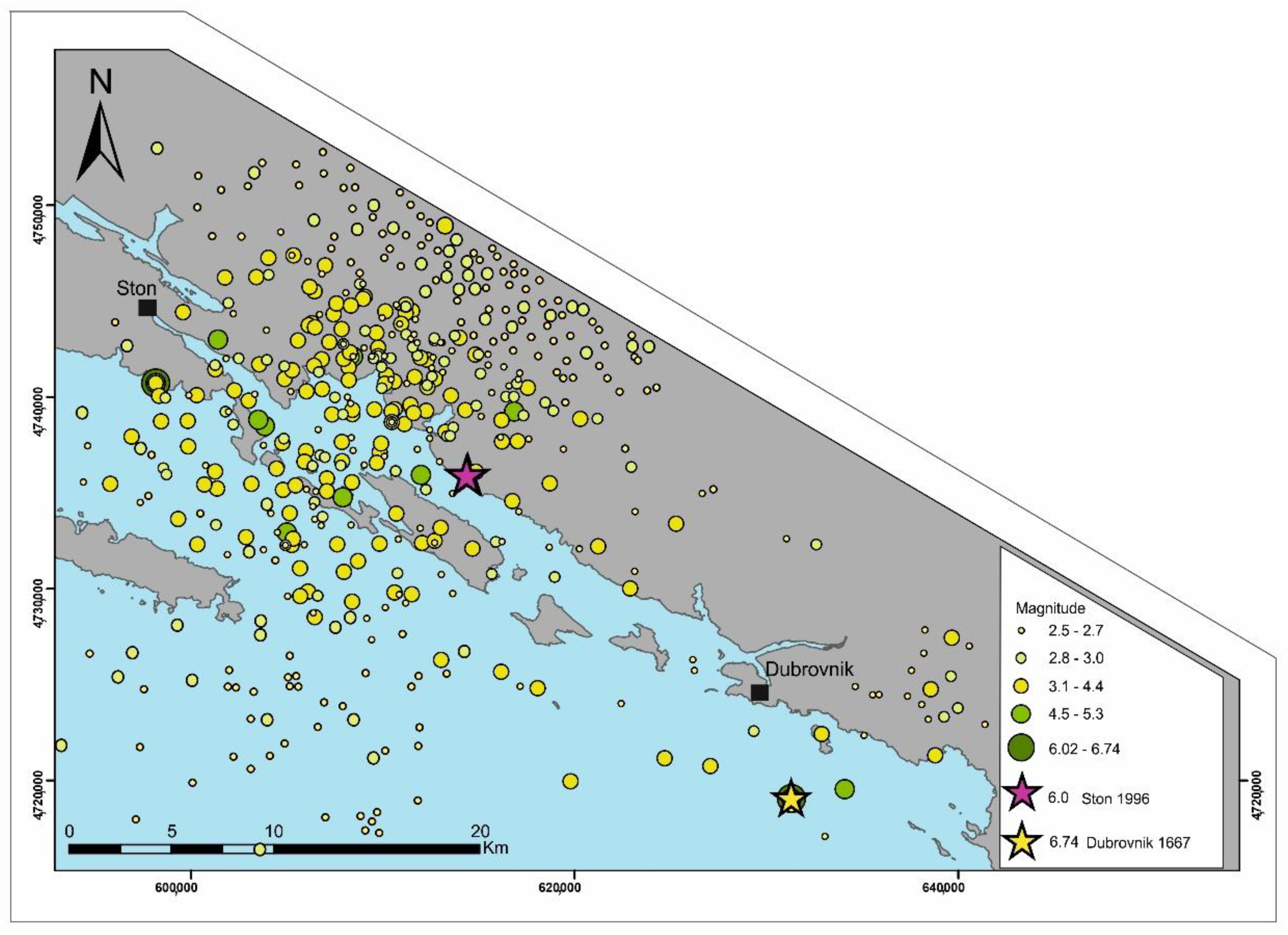
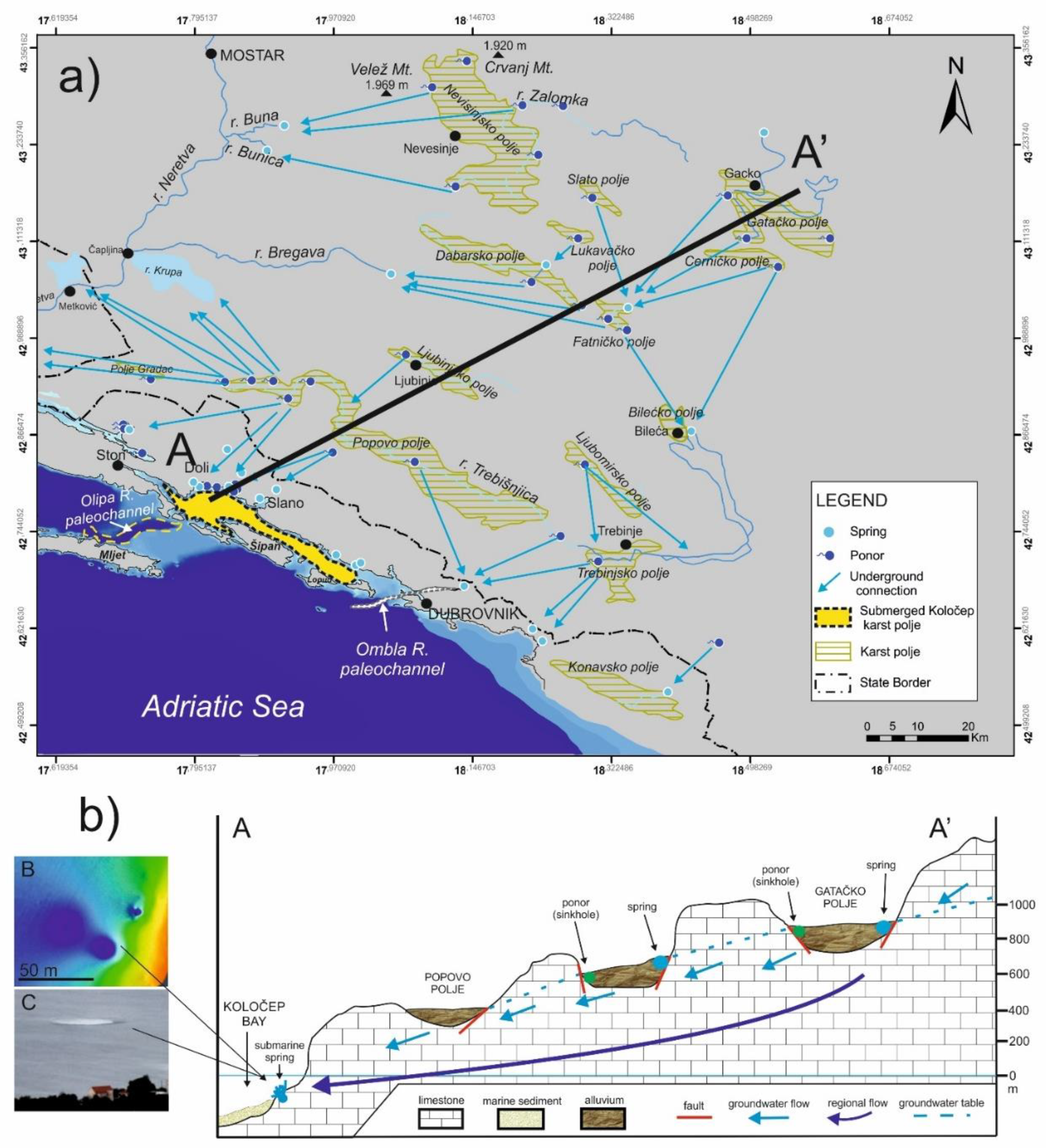


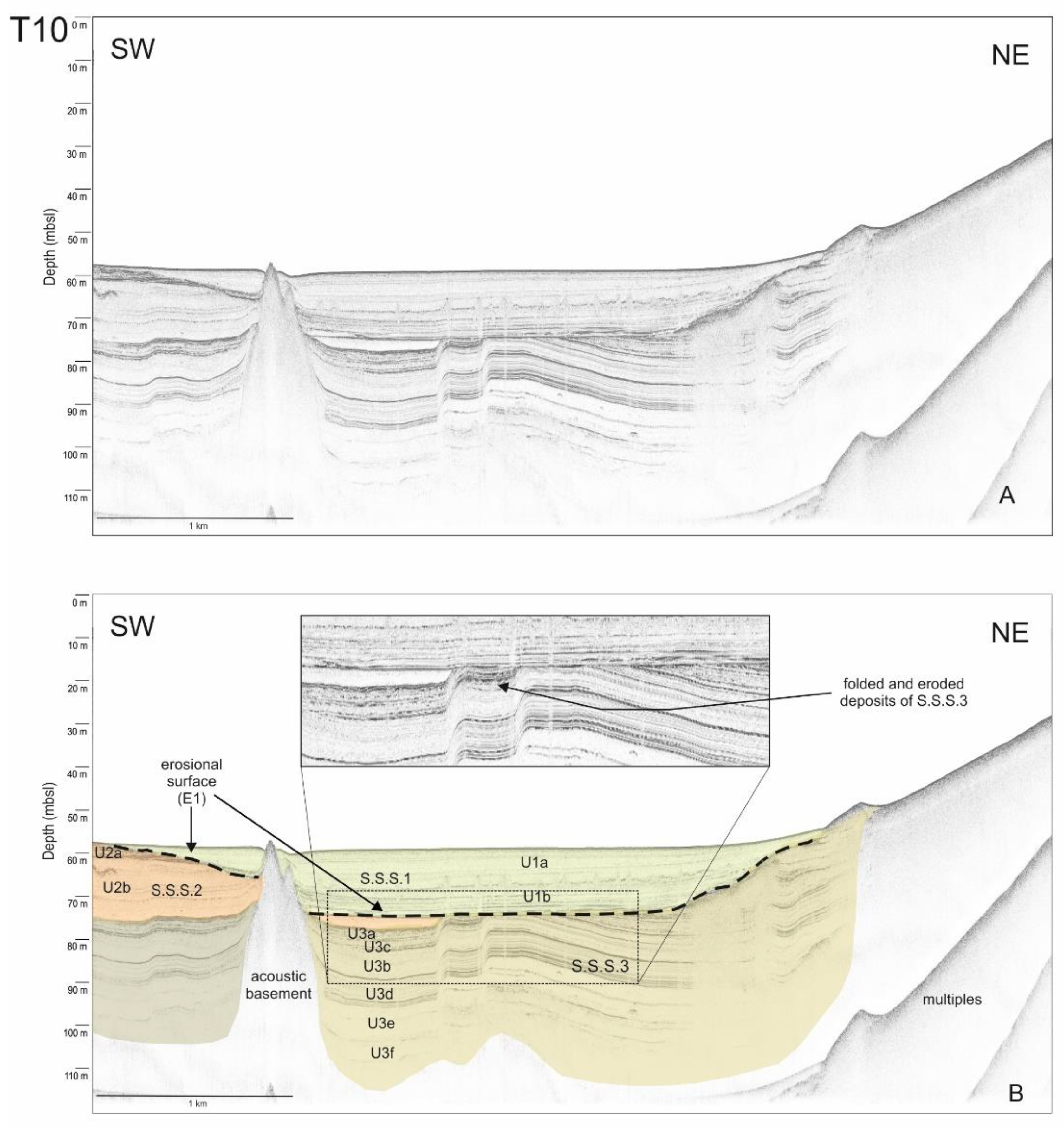
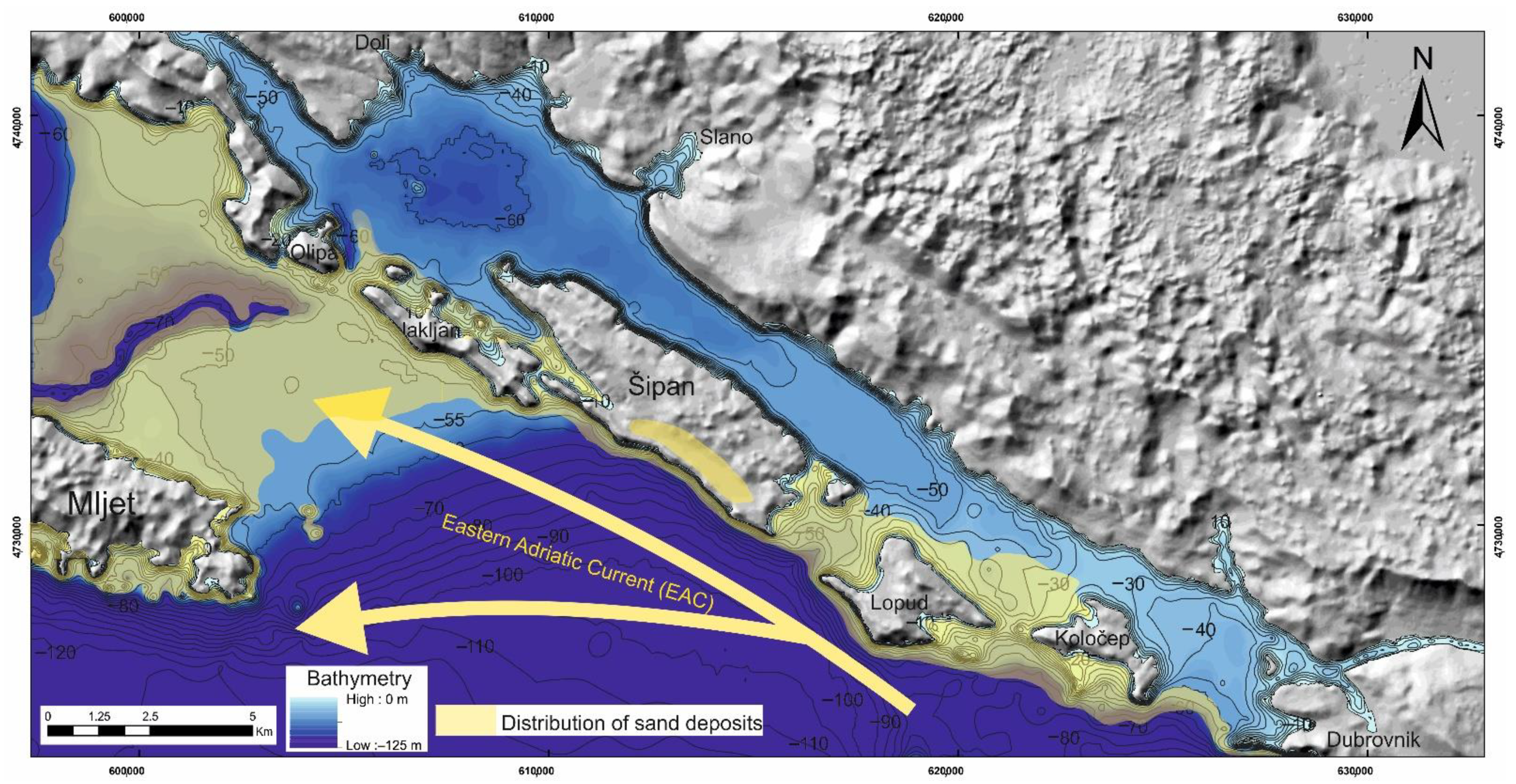
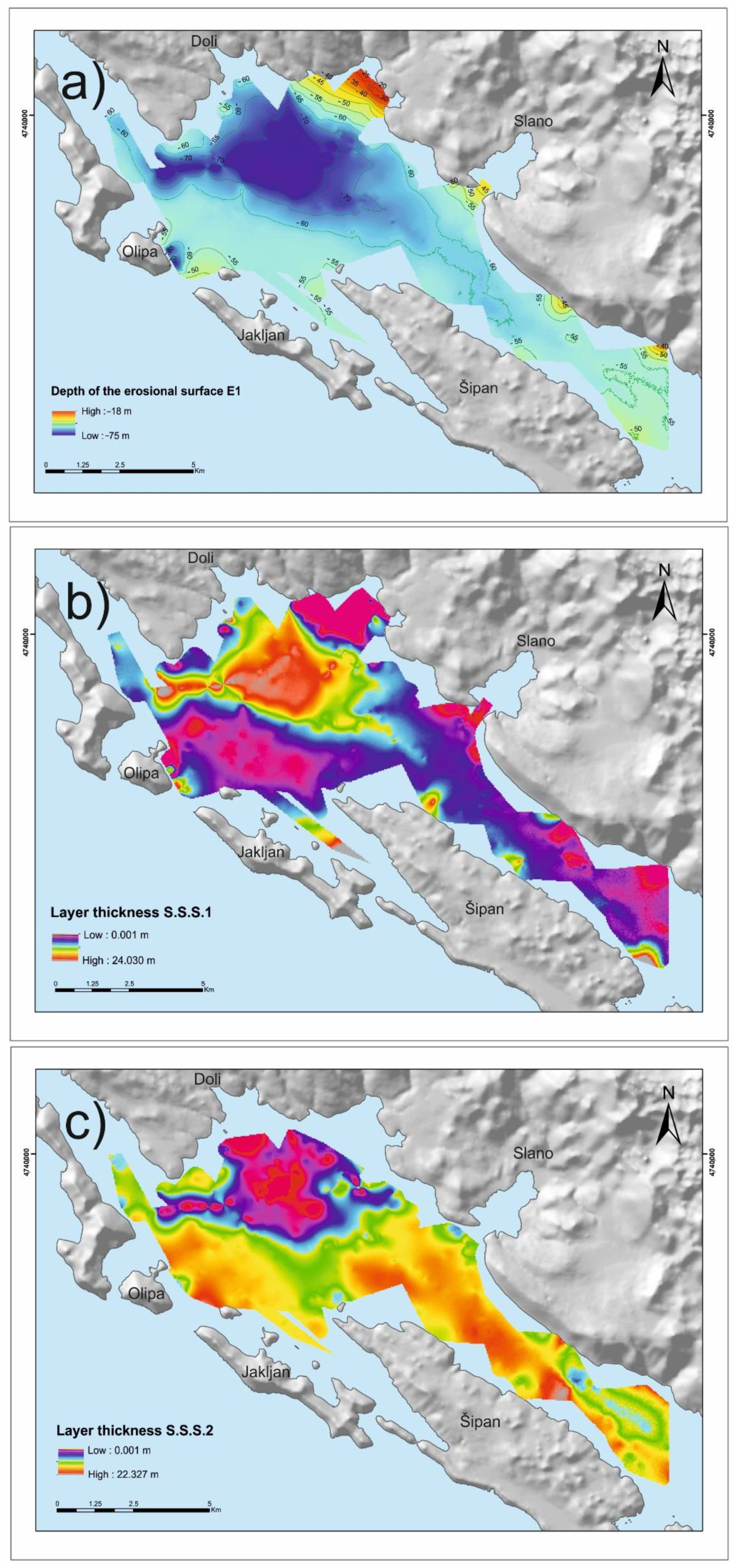

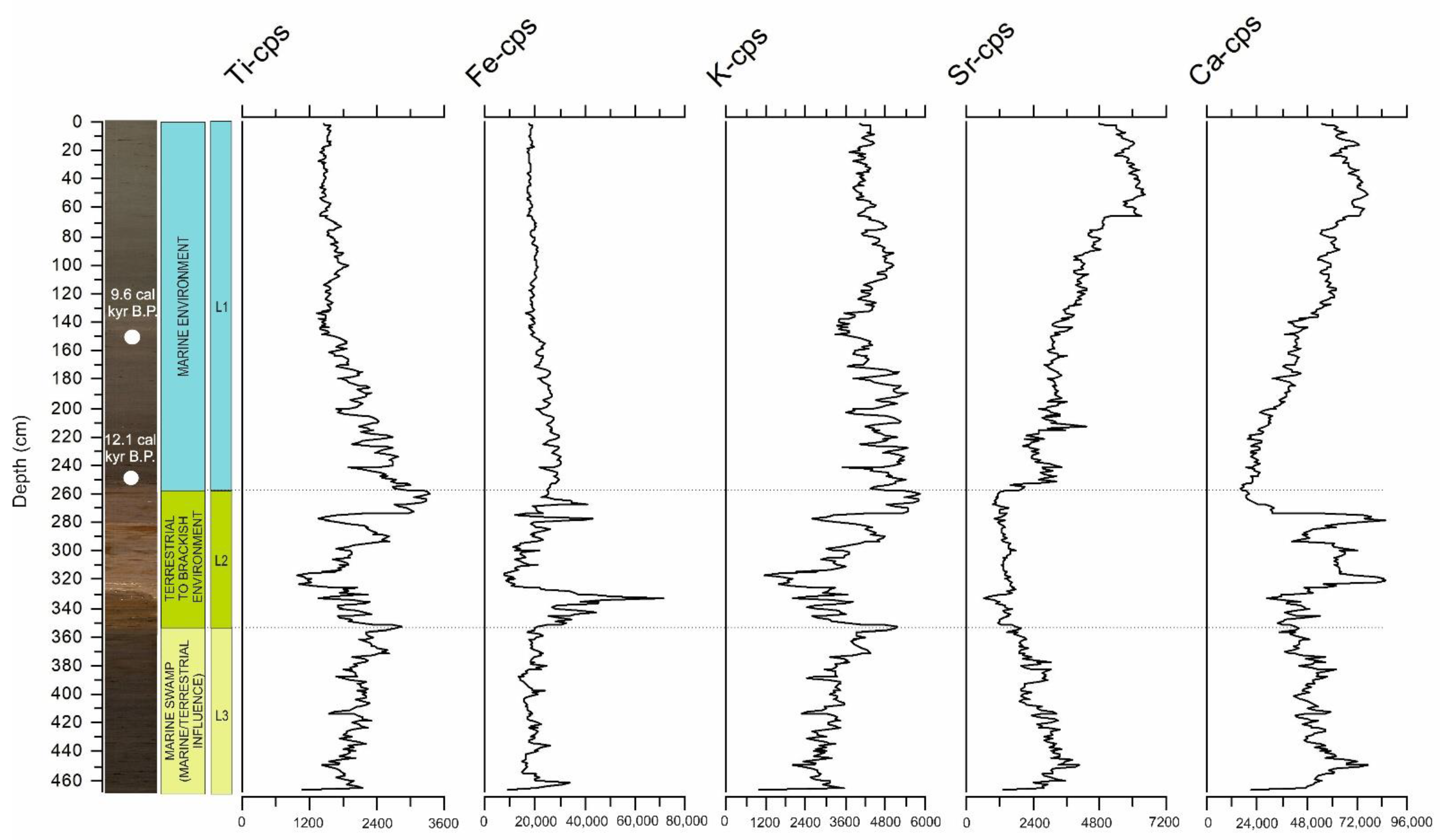


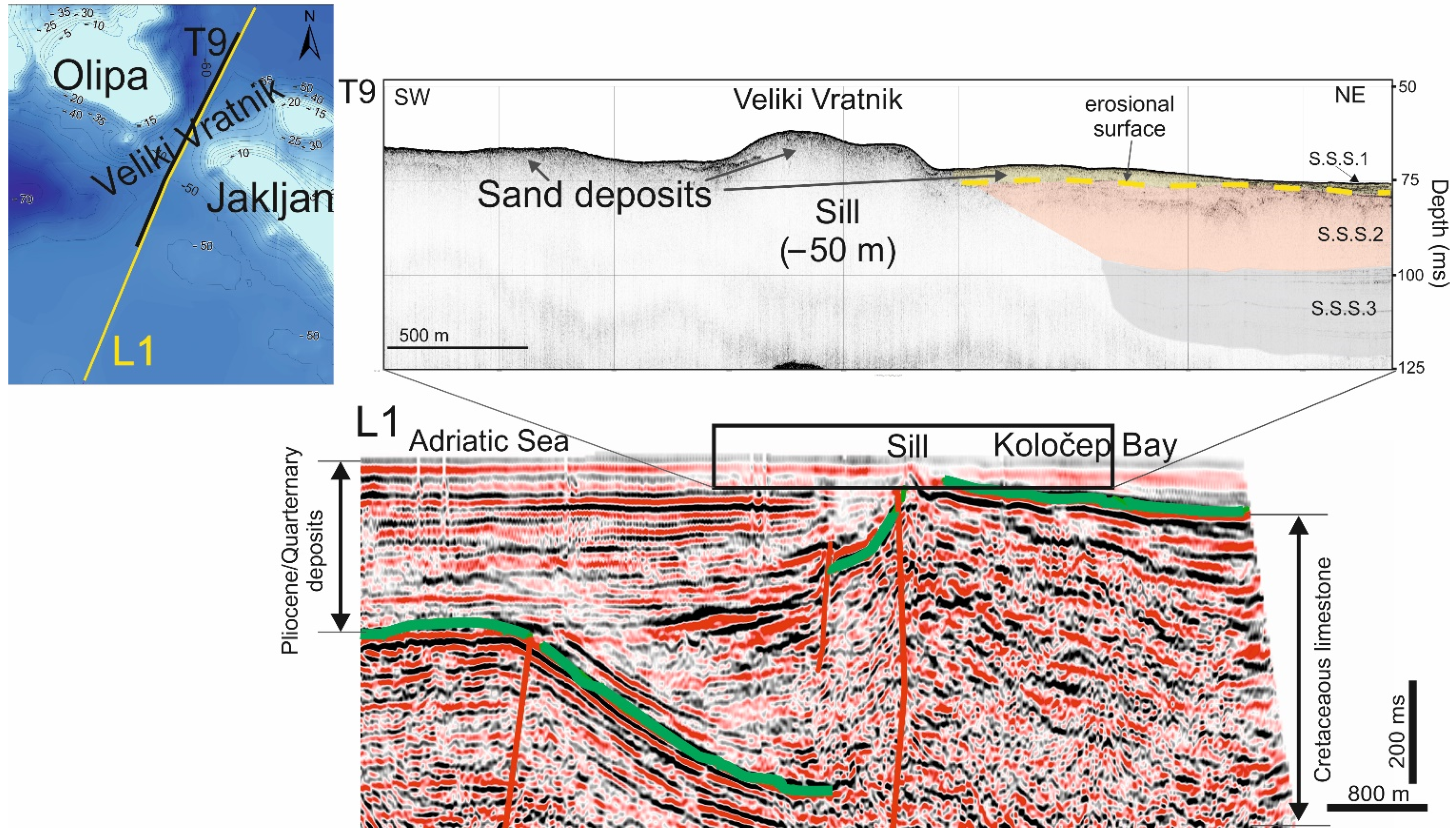
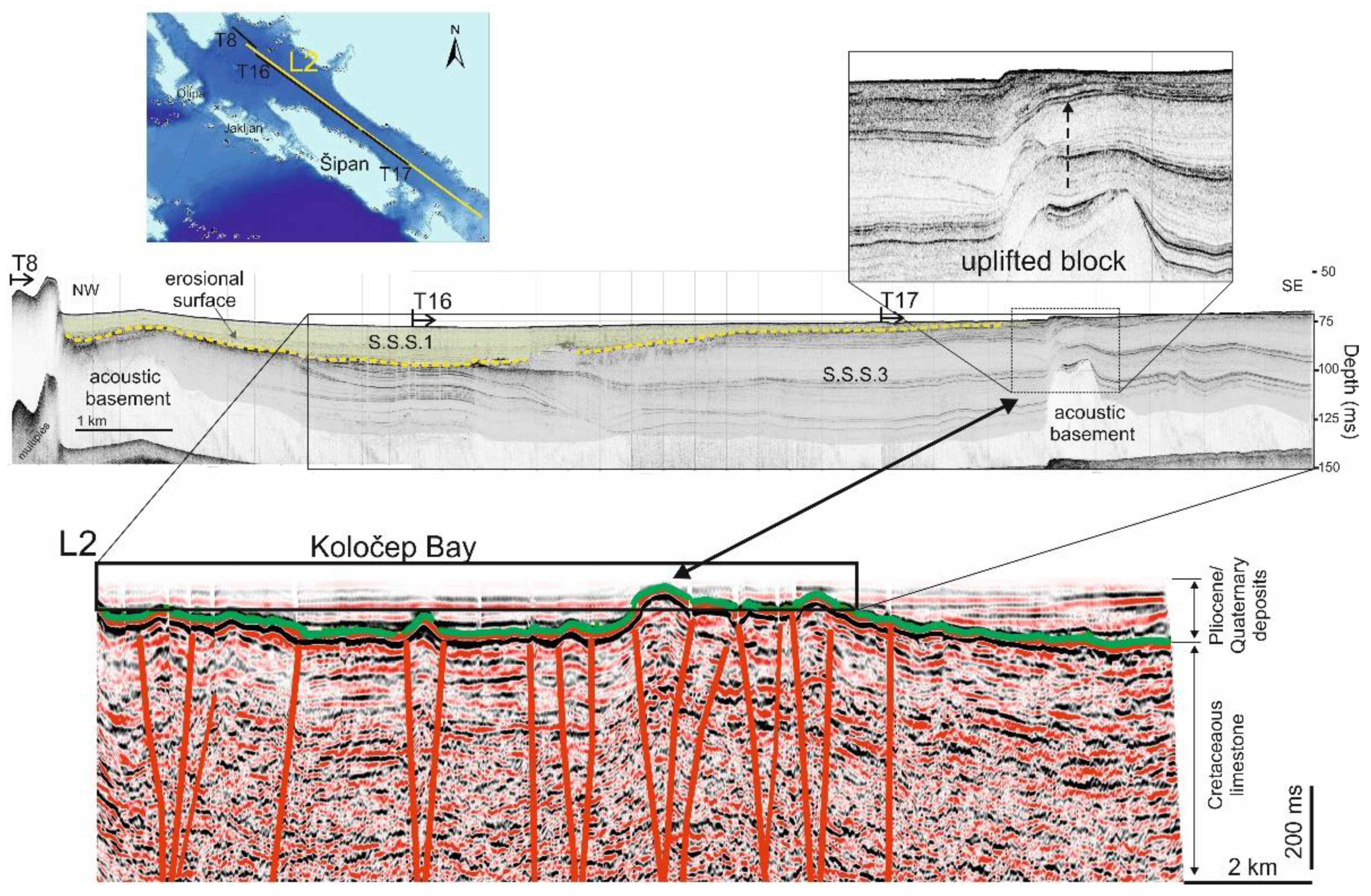

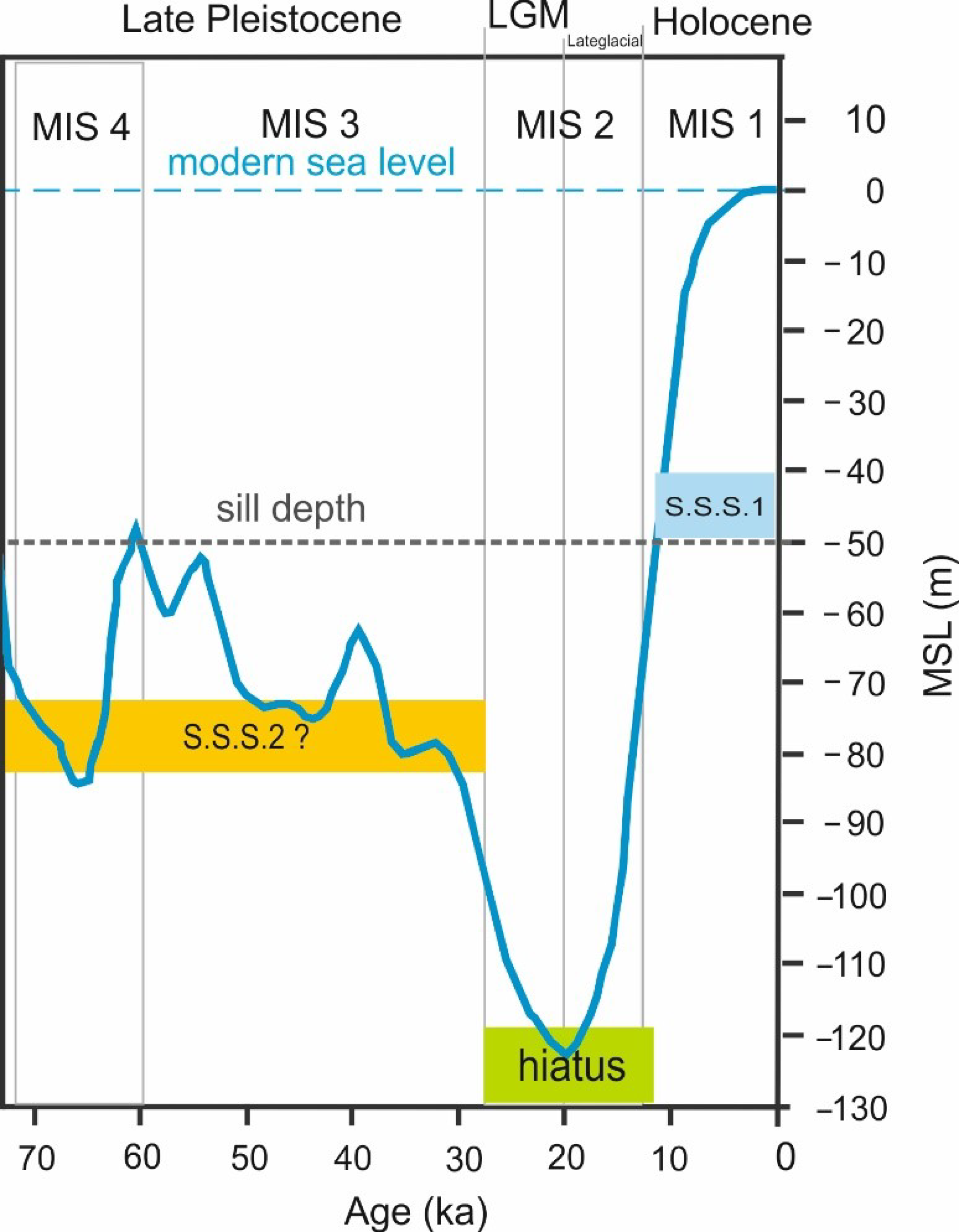
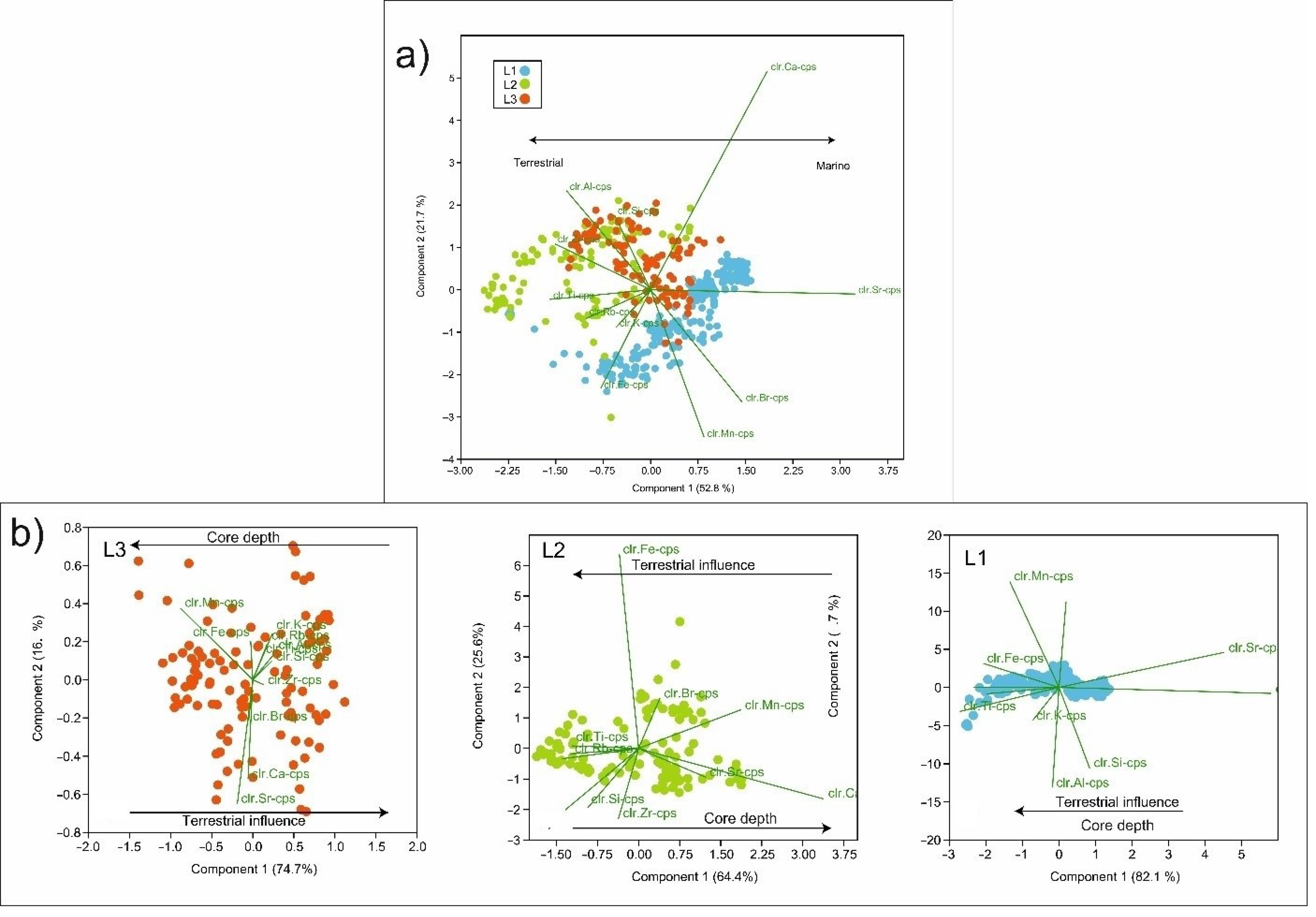
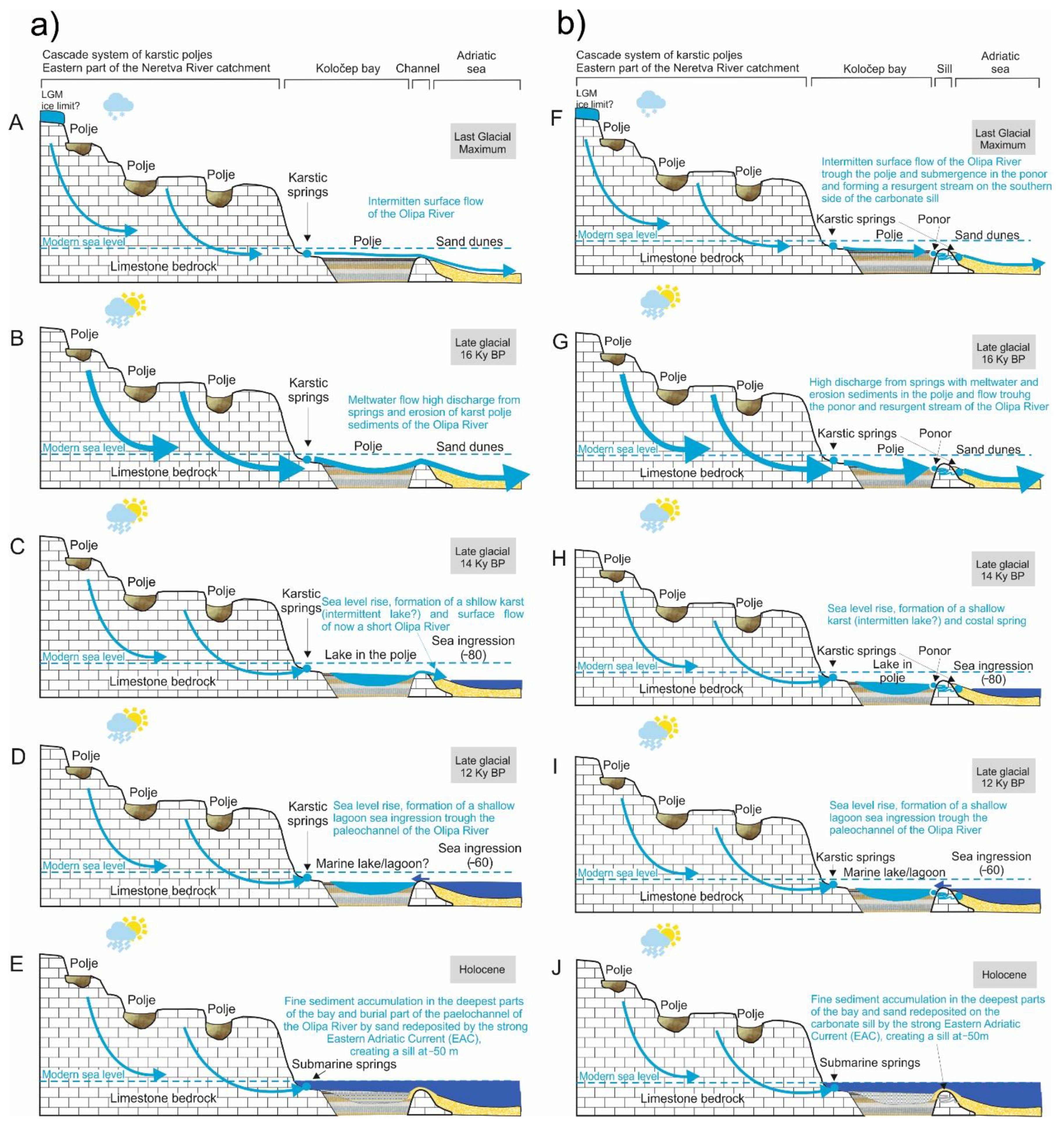
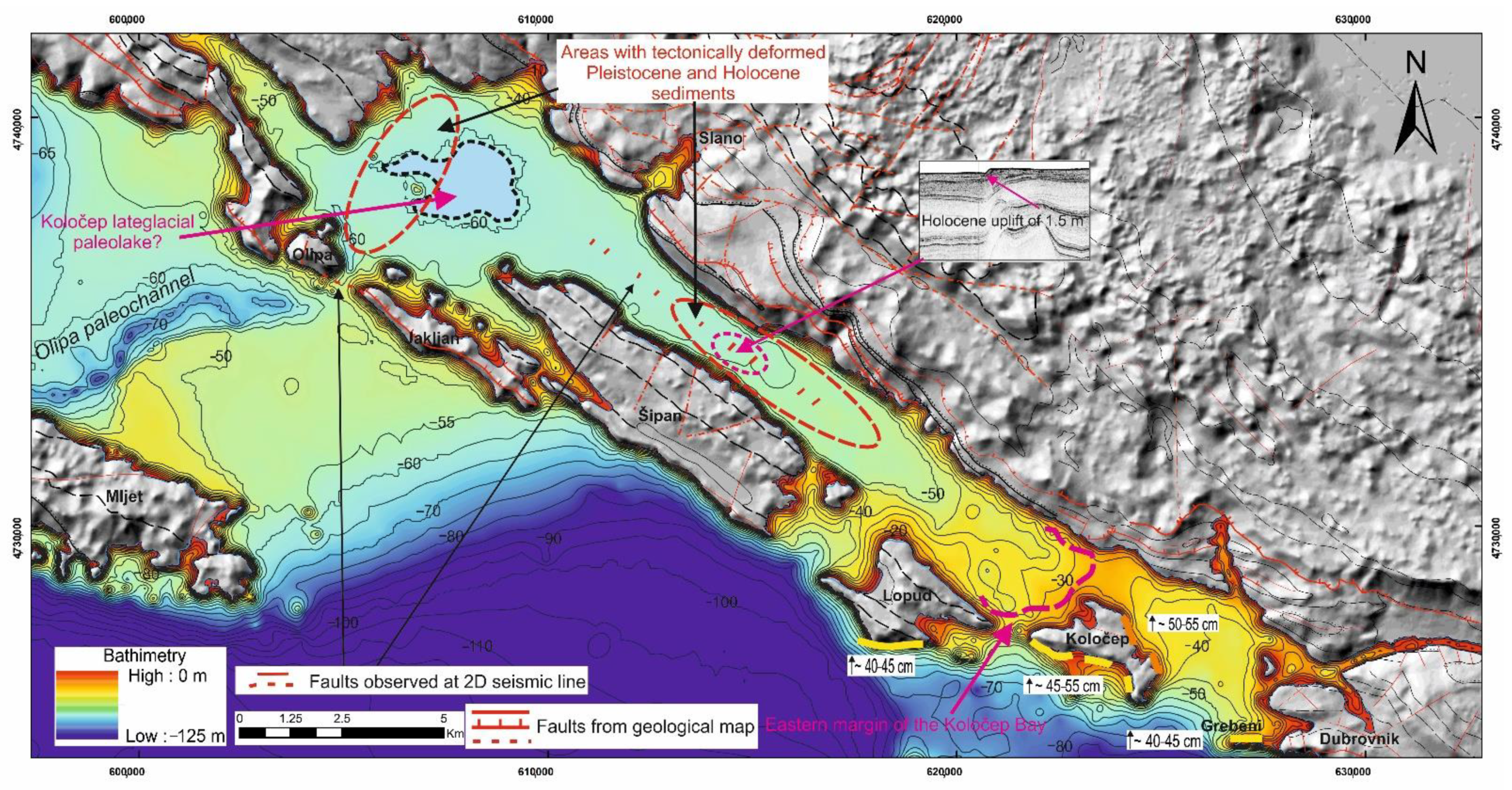

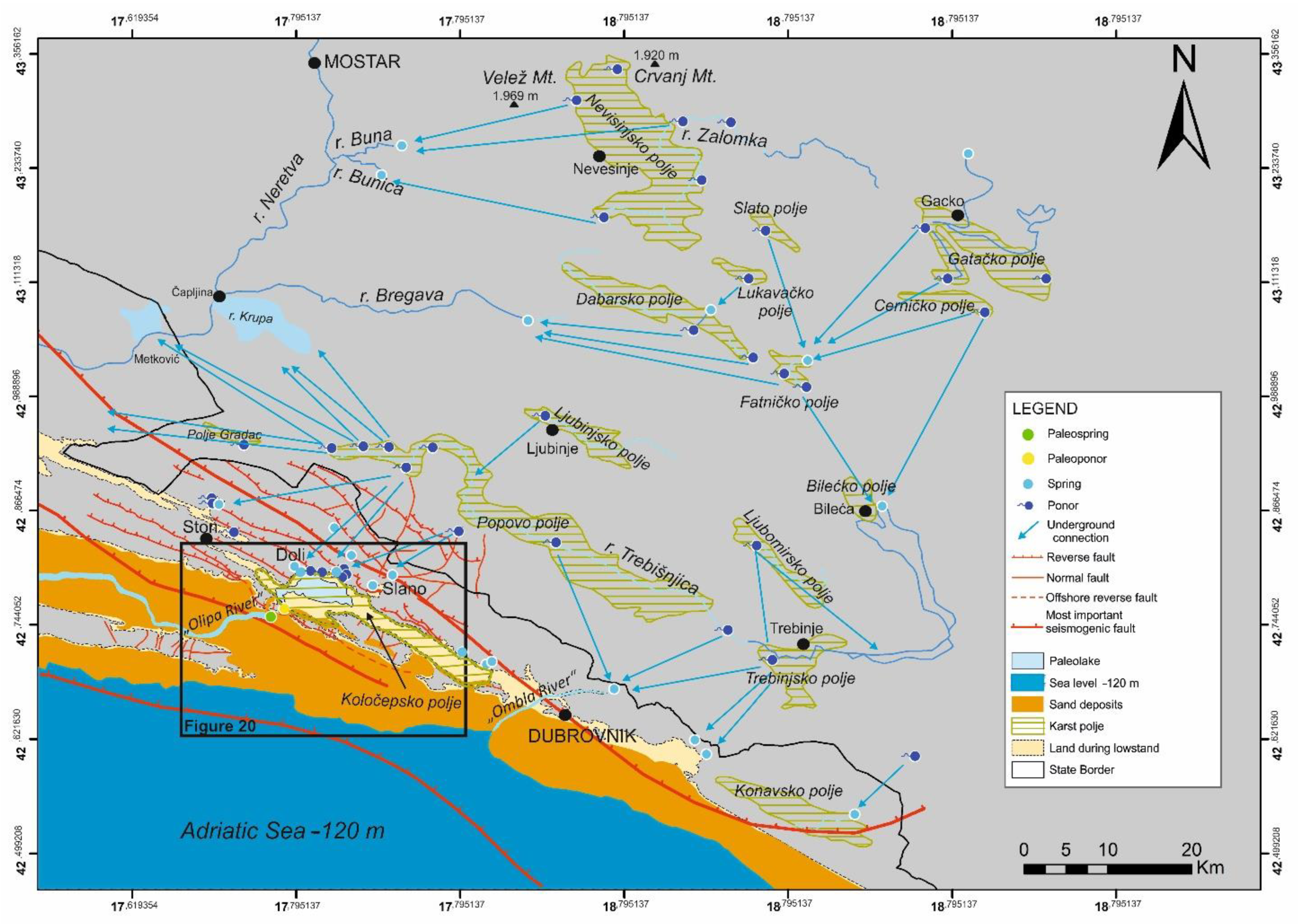
| Core Name | Total Core Length (cm) | Coordinates | Laboratory Number | Sample Depth (cm) | Material | δ 13C (‰) | Conventional Radiocarbon Age (B.P.) | Probability (%) | Calibrated Age (Cal B.P.) |
|---|---|---|---|---|---|---|---|---|---|
| KK-1 | 470 | (X) 17°50′4, 910″ E | Beta-468182 | 157–158 | shell | +1.3 | 9050 ± 30 | 95.4% | 9669 |
| (Y) 42°46′0, 581″ N | Beta-468183 | 251.5–253.5 | shell | +1.4 | 10,780 ± 30 | 95.4% | 12,170 |
Publisher’s Note: MDPI stays neutral with regard to jurisdictional claims in published maps and institutional affiliations. |
© 2022 by the authors. Licensee MDPI, Basel, Switzerland. This article is an open access article distributed under the terms and conditions of the Creative Commons Attribution (CC BY) license (https://creativecommons.org/licenses/by/4.0/).
Share and Cite
Šolaja, D.; Miko, S.; Brunović, D.; Ilijanić, N.; Hasan, O.; Papatheodorou, G.; Geraga, M.; Durn, T.; Christodoulou, D.; Razum, I. Late Quaternary Evolution of a Submerged Karst Basin Influenced by Active Tectonics (Koločep Bay, Croatia). J. Mar. Sci. Eng. 2022, 10, 881. https://doi.org/10.3390/jmse10070881
Šolaja D, Miko S, Brunović D, Ilijanić N, Hasan O, Papatheodorou G, Geraga M, Durn T, Christodoulou D, Razum I. Late Quaternary Evolution of a Submerged Karst Basin Influenced by Active Tectonics (Koločep Bay, Croatia). Journal of Marine Science and Engineering. 2022; 10(7):881. https://doi.org/10.3390/jmse10070881
Chicago/Turabian StyleŠolaja, Dragana, Slobodan Miko, Dea Brunović, Nikolina Ilijanić, Ozren Hasan, George Papatheodorou, Maria Geraga, Tatjana Durn, Dimitris Christodoulou, and Ivan Razum. 2022. "Late Quaternary Evolution of a Submerged Karst Basin Influenced by Active Tectonics (Koločep Bay, Croatia)" Journal of Marine Science and Engineering 10, no. 7: 881. https://doi.org/10.3390/jmse10070881
APA StyleŠolaja, D., Miko, S., Brunović, D., Ilijanić, N., Hasan, O., Papatheodorou, G., Geraga, M., Durn, T., Christodoulou, D., & Razum, I. (2022). Late Quaternary Evolution of a Submerged Karst Basin Influenced by Active Tectonics (Koločep Bay, Croatia). Journal of Marine Science and Engineering, 10(7), 881. https://doi.org/10.3390/jmse10070881











